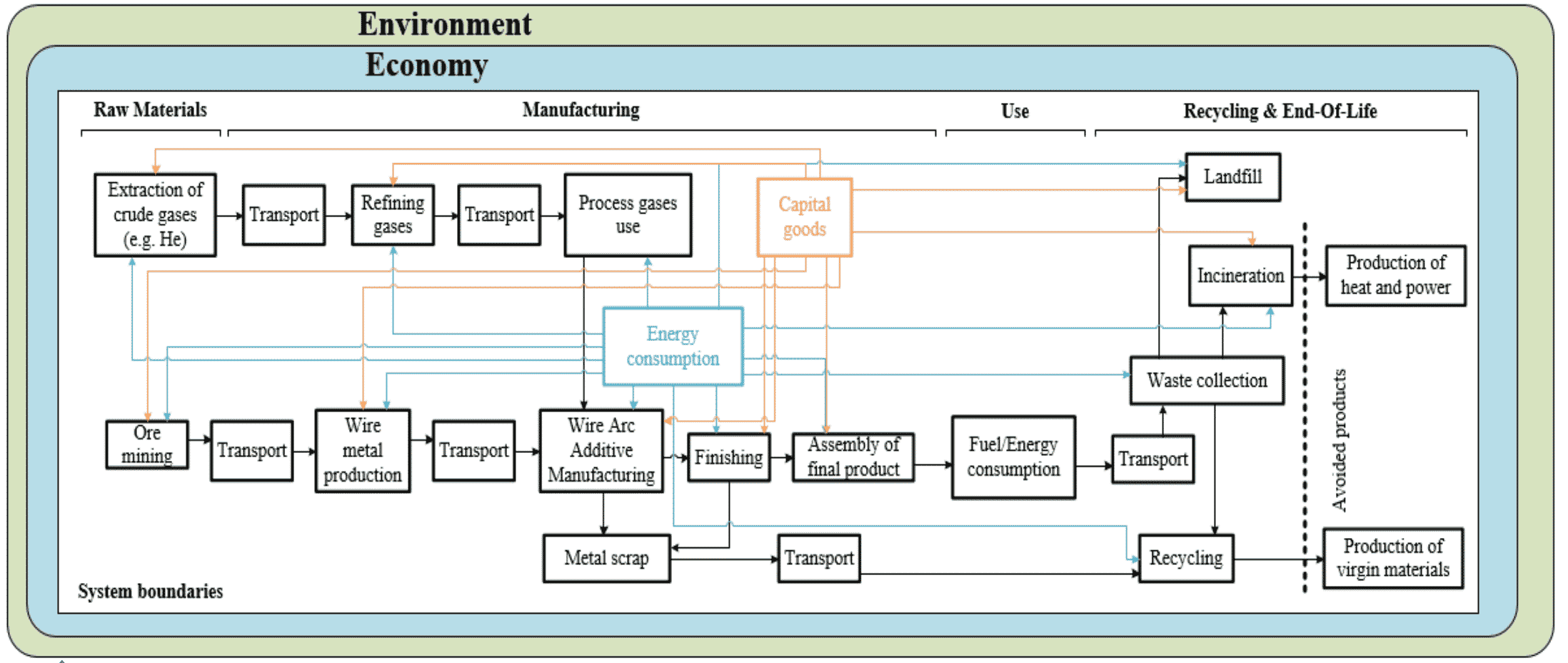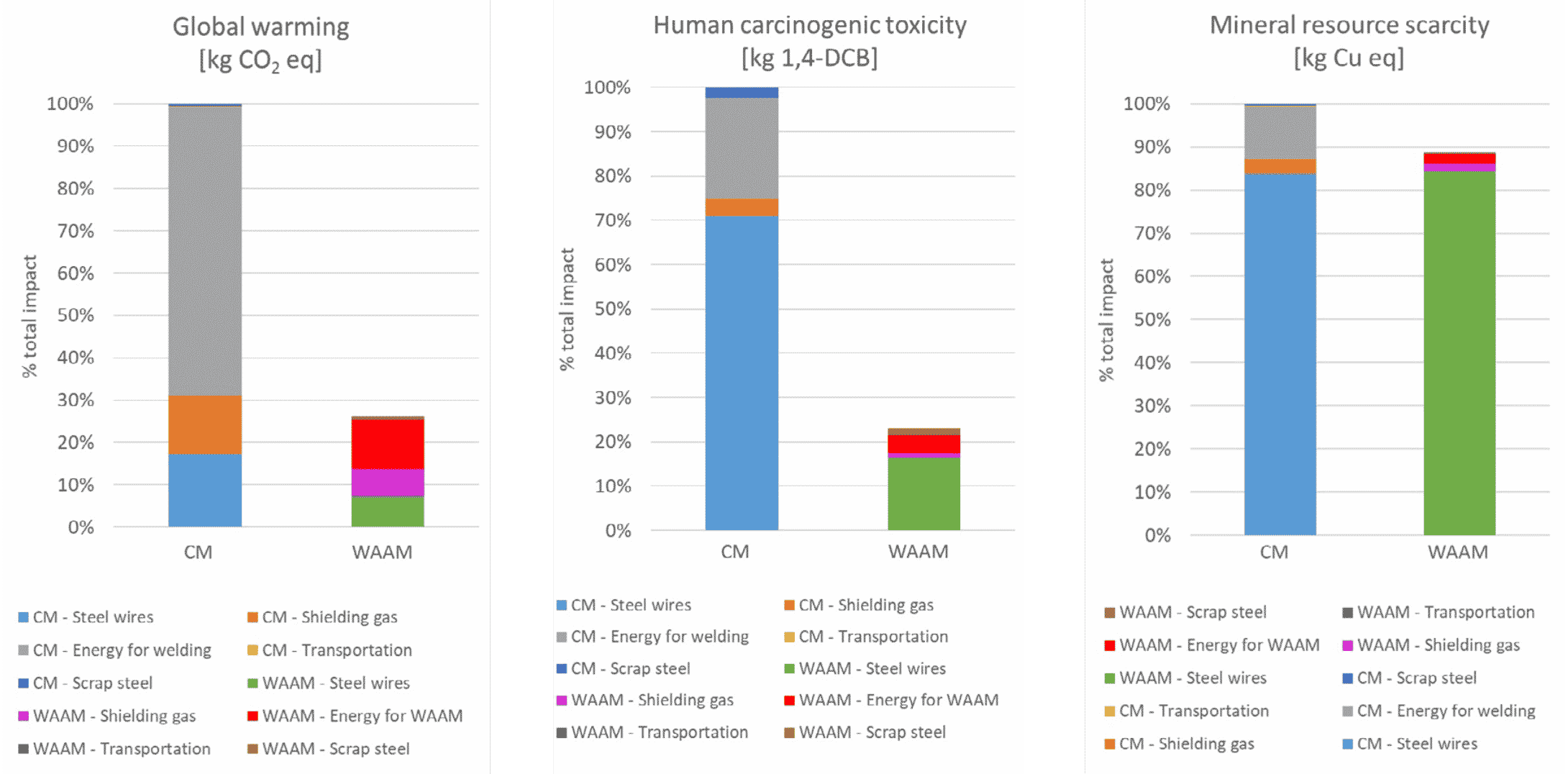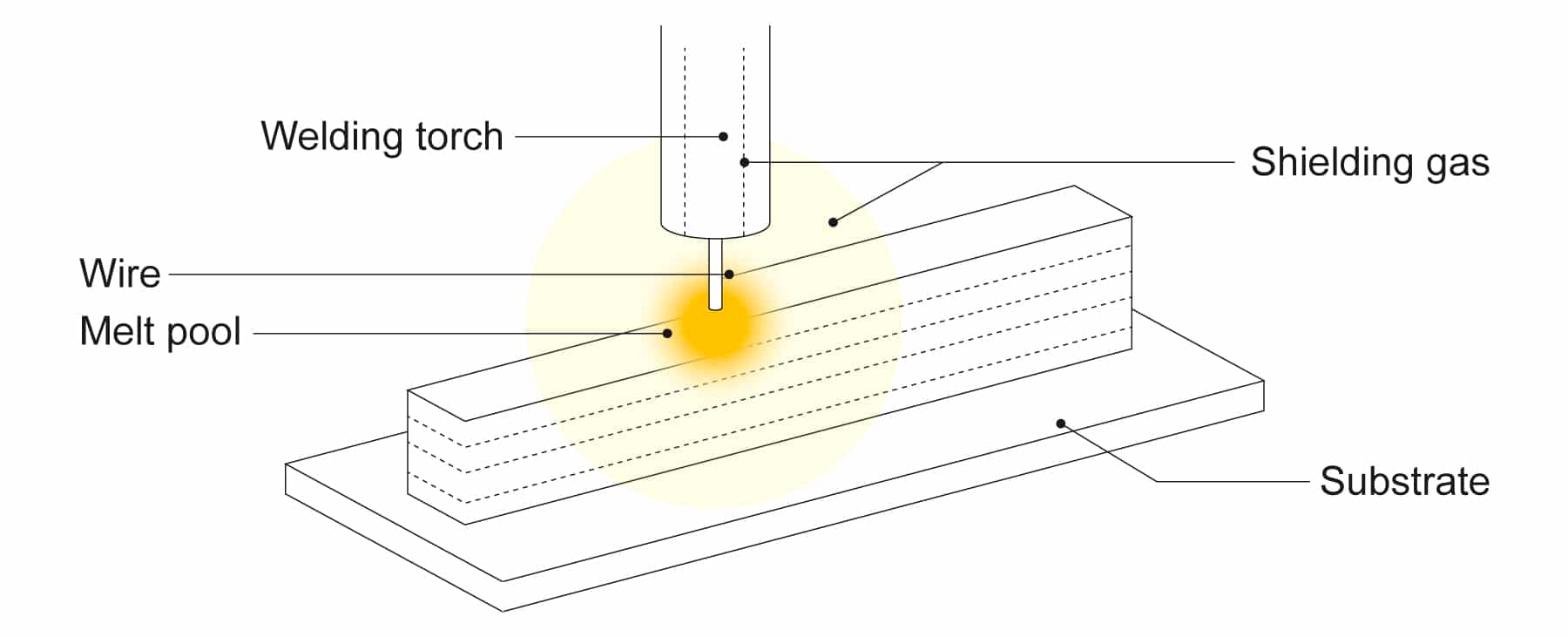Determining the sustainability of wire and arc additive manufacturing
Constantinos Goulas, Assistant Professor, University of Twente & Scientific Advisor RAMLAB BV
Valentina Pusateri, PhD Candidate, Technical University of Denmark (DTU)
Duman Kamalebieke, Research Assistant, Technical University of Denmark (DTU)
Stig Irving Olsen, Associate Professor, Technical University of Denmark (DTU)
Additive manufacturing is branching out to yield greater potential to reduce material usage and environmental impact, as demonstrated by lifecycle assessments (LCA).
Wire and arc additive manufacturing (WAAM) is a derivative of the additive manufacturing (AM) process that uses an electric arc as a heat source to melt a wire feedstock in order to create a composite structure. It is a very promising technology that can produce large metallic structures with high deposition rates at a reduced cost compared with other competing AM technologies. Current WAAM hardware generally uses standard welding equipment, including the power source, welding torch, and wire feeding system. As it is the case with standard additive manufacturing processes, WAAM production is now largely automated using a combination of robotic systems and computer numerical control (CNC) gantries.
Although first patented almost a century ago, WAAM has only recently been investigated as a more viable alternative to traditional manufacturing processes. Its increased viability is largely a result of the growing adoption of modern computerised systems that allow for additional design flexibility, support for a broader range of materials, and extensive automation. As such, it offers a new approach to additive manufacturing that promises to be more sustainable, cost-effective, and scalable.
In spite of recent developments, however, there are still some important trade-offs to consider and inherent challenges that must be addressed. These include limitations to the volume, size, and range of materials used, as well as a data-driven strategy to drive decision-making and automation. To benefit from the adoption of WAAM, manufacturers must look beyond the
traditional cost and sustainability models and metrics to determine the true impact and whether it makes sense for their manufacturing processes.
How sustainable is additive manufacturing?
WAAM is a branch of additive manufacturing, the process commonly referred to colloquially as 3D printing. Proponents of the method claim several benefits, such as reduced energy and fuel consumption, materials usage, and environmental impact. Further purported advantages include cost reduction due to better optimisation of shapes, more lightweight design, and the shorter production cycles that come with increased reliance on robotics, data, and automation.

Figure 2: System boundaries considered in LCA and LCC models of Grade2XL products
However, many manufacturers continue to embrace more traditional production methods, as they have yet to be convinced that WAAM is suitable for their processes due to mainly cost and performance concerns. While these are being improved, another independent factor might be proven decisive for the broad acceptance of the technology, and this is its sustainability. Can the environmental impact of a component be reduced if produced by WAAM instead of, for example, casting? To validate the claims championing WAAM, it is important to take a life cycle perspective which addresses the environmental and economic sustainability more broadly. The ultimate aim is to tackle environmental impacts head on, while still being able to realise the cost and performance benefits of WAAM.
To achieve these goals, manufacturers can turn to industry-standard decisionsupport tools used to quantify the environmental and economic sustainability impact of WAAM. These are the Lifecycle Assessment (LCAs) and Life Cycle Costing (LCC), both
of which explore the sustainability of manufacturing processes from the extraction of raw materials to the disposal
of the product.
In the Grade2XL project, funded by the European Commission in the framework of Horizon 2020, we investigate the application of multi-material WAAM to produce and test 9 industrial demonstrator components.
These demonstrators are great cases for testing the hypotheses about AM used for LCA calculations, get accurate data for this novel way of producing metal parts and assess with confidence how sustainable the WAAM process really is. Our approach includes substituting the bulk use of expensive/critical materials with more economically and environmentally sustainable metal combinations that can deliver equal or superior performance at a competitive price, with a reduced environmental footprint.
For all the reasons previously mentioned, LCA and LCC frameworks are currently used to compare the sustainability of all Grade2XL demonstrators to the same objects fabricated with the traditional manufacturing processes. Figure 2 represents a generic overview of all life cycle processes considered for Grade2XL demonstrators produced with WAAM.
The processes illustrated above are included in the LCA and LCC models, which provide the environmental and economic impact of each Grade2XL demonstrators, respectively. Our first case study focuses on the repair process of hot forging dies using the WAAM technology. Repair cases are particularly attractive for multiple reasons: 1) The service life of a component is extended, 2) the performance of the component can be enhanced after repair by using high performing materials, 3) the welding operations are performed by a machine instead of manually welding the worn surface, which protects the health of the operator.
Regarding the environmental impact, our first analysis shows that the main factors contributing to the sustainability of the
process are the energy and the materials used.
For instance, Figure 3 illustrates the preliminary results of the LCA of the repair of a forging with WAAM and conventional welding for three selected impact categories, namely Global warming, Human carcinogenic toxicity, and Mineral resource scarcity.

Figure 3: Internally normalized impact score for Kuznia Jawor forging die repair by conventional welding (columns on the left) and WAAM (columns on the right) with process contribution analysis for three-selected impact categories.
These diagrams enable to see the quite visible better environmental performance of WAAM over conventional processes. It is also clear that, in general, the steel wires and the energy used during repair are the major contributors to both type
of manufacturing processes. Therefore, Wire-Arc Additive Manufacturing showed potential in terms of sustainability, which
should be further investigate for different products and applications.
For the Twente region of the Netherlands, the local manufacturing industry is evolving and begins to adopt novel technologies like additive manufacturing and automation technology in their production. These technologies are constantly evolving to spur innovation, grow the regional economy, and lead the way to a more sustainable future.
That being said, local decision makers often face a complex set of information regarding manufacturing of products that includes technical, economic, and environmental information. Each novel manufacturing method comes with its own optimal set of use cases, hence the need for firms to be able to accurately evaluate their options. Demonstrating the sustainability of any given production method using a lifecycle assessment offers a standardized and proven way to do precisely that.

Figure 4: An example of a WAAM process